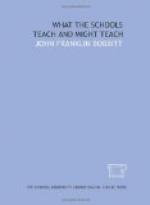13. Physical training is given about as much time as in the average city, but without adequate facilities for outdoor and indoor plays and games. At present the work is too largely of the formal gymnastic type. Desirable improvements in the course are being advocated by the directors and supervisors of the work. They are recommending and introducing, where conditions will permit, the use of games, athletics, folk dances, and the like. The movement should be promoted in every possible way.
14. In the elementary schools Cleveland gives more than the average amount of time to music, but in the high schools the subject is developed only incidentally and is given no credit. It is a question whether this arrangement is the right one, and in considering possible extensions it should be remembered that there are other subjects of far more pressing immediate necessity.
15. It is impossible in this brief report to discuss adequately so complicated a matter as that of the teaching of foreign languages in the high schools, but some of the most important of the questions at issue have been indicated as matters which the school authorities should continue to study until satisfactory solutions are reached.
16. Where school work in Cleveland is backward, it is because it has not yet taken on the social point of view. Where it is progressive, it is being developed on the basis of human needs. There is much of both kinds of work in Cleveland.
17. In a city with a population so diversified as is that of Cleveland, progress should be made steadily and consciously away from city-wide uniformity in courses of study and methods of teaching. There should be progressive differentiation of courses to meet the widely varying needs of the different sorts of children in different sections of the city.
CLEVELAND EDUCATION SURVEY REPORTS
These reports can be secured from the Survey Committee of the Cleveland Foundation, Cleveland, Ohio. They will be sent postpaid for 25 cents per volume with the exception of “Measuring the Work of the Public Schools” by Judd, “The Cleveland School Survey” by Ayres, and “Wage Earning and Education” by Lutz. These three volumes will be sent for 50 cents each. All of these reports may be secured at the same rates from the Division of Education of the Russell Sage Foundation, New York City.
Child Accounting in the Public Schools—Ayres.
Educational Extension—Perry.
Education through Recreation—Johnson.
Financing the Public Schools—Clark.
Health Work in the Public Schools—Ayres.
Household Arts and School Lunches—Boughton.
Measuring the Work of the Public Schools—Judd.
Overcrowded Schools and the Platoon Plan—Hartwell.
School Buildings and Equipment—Ayres.
Schools and Classes for Exceptional Children—Mitchell.
School Organization and Administration—Ayres.
The Public Library and the Public Schools—Ayres
and McKinnie.
The School and the Immigrant—Miller.
The Teaching Staff—Jessup.
What the Schools Teach and Might Teach—Bobbitt.
The Cleveland School Survey (Summary)—Ayres.




